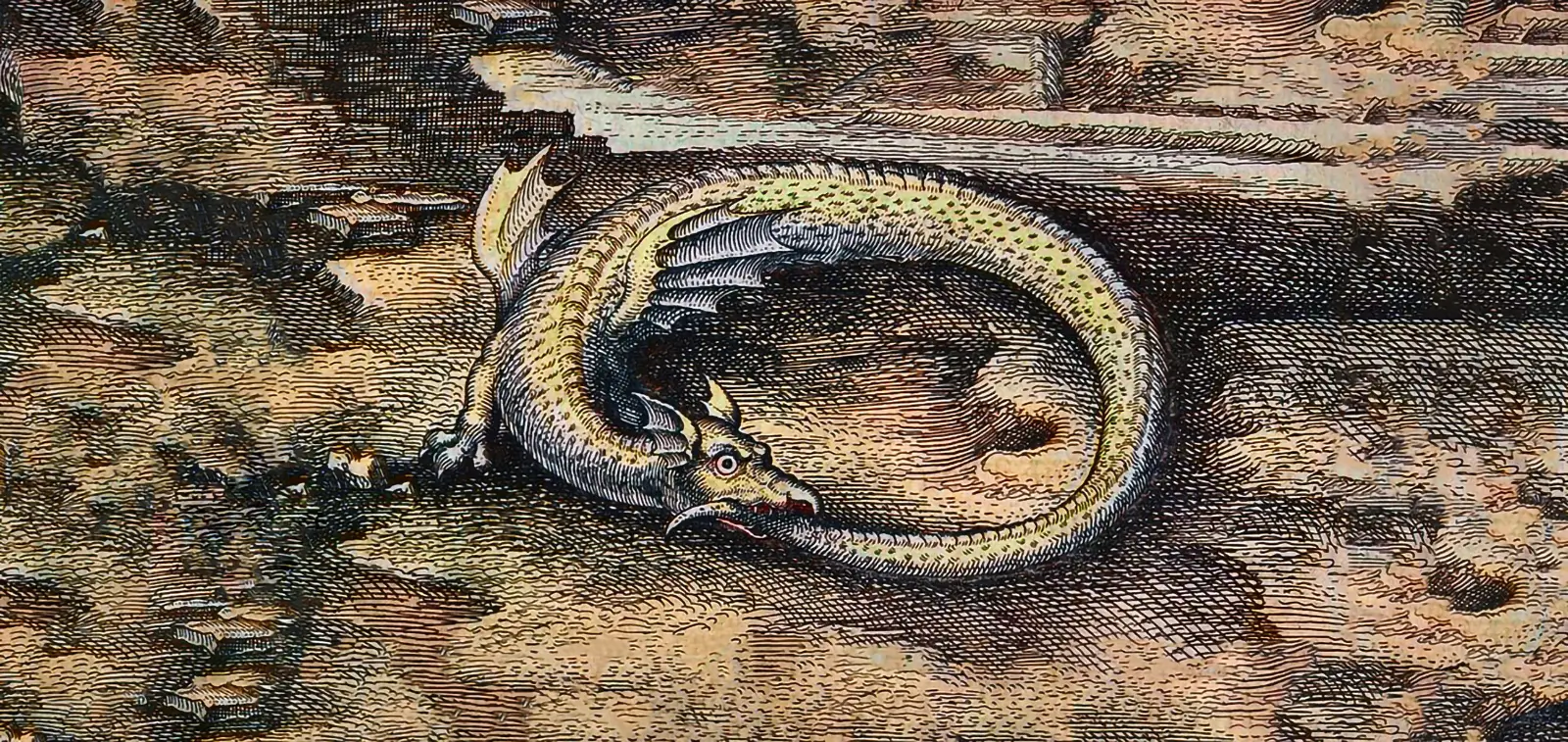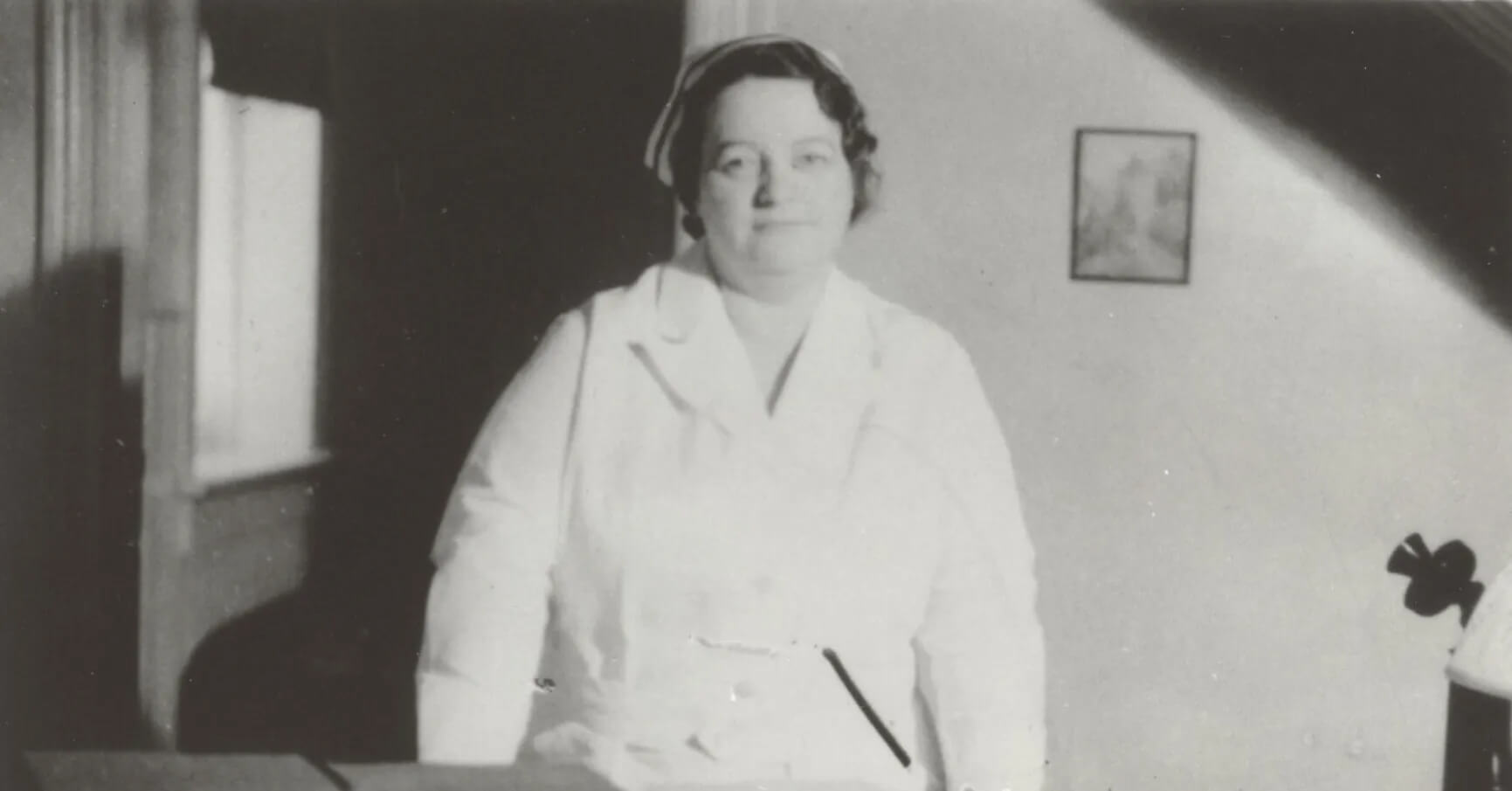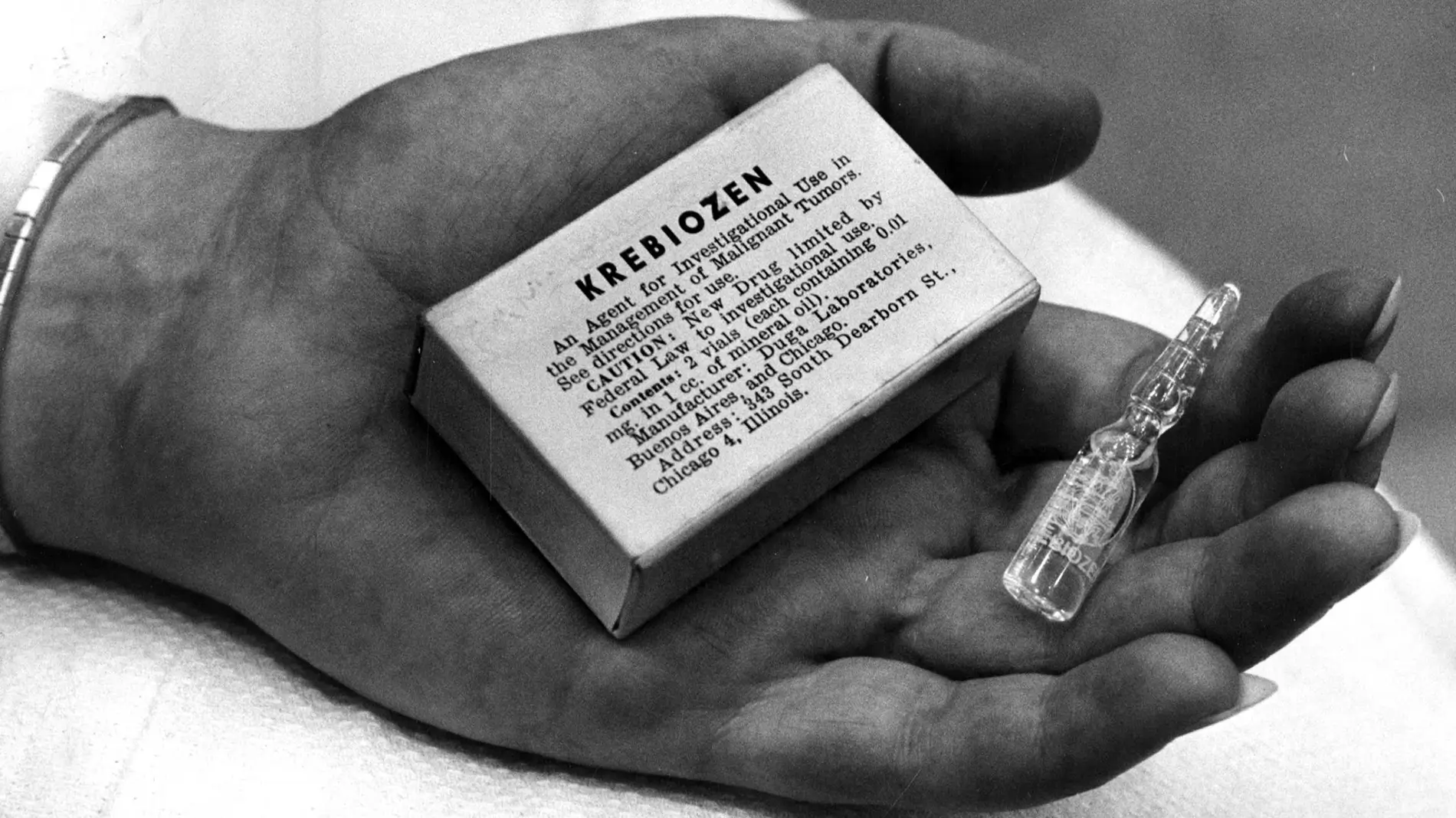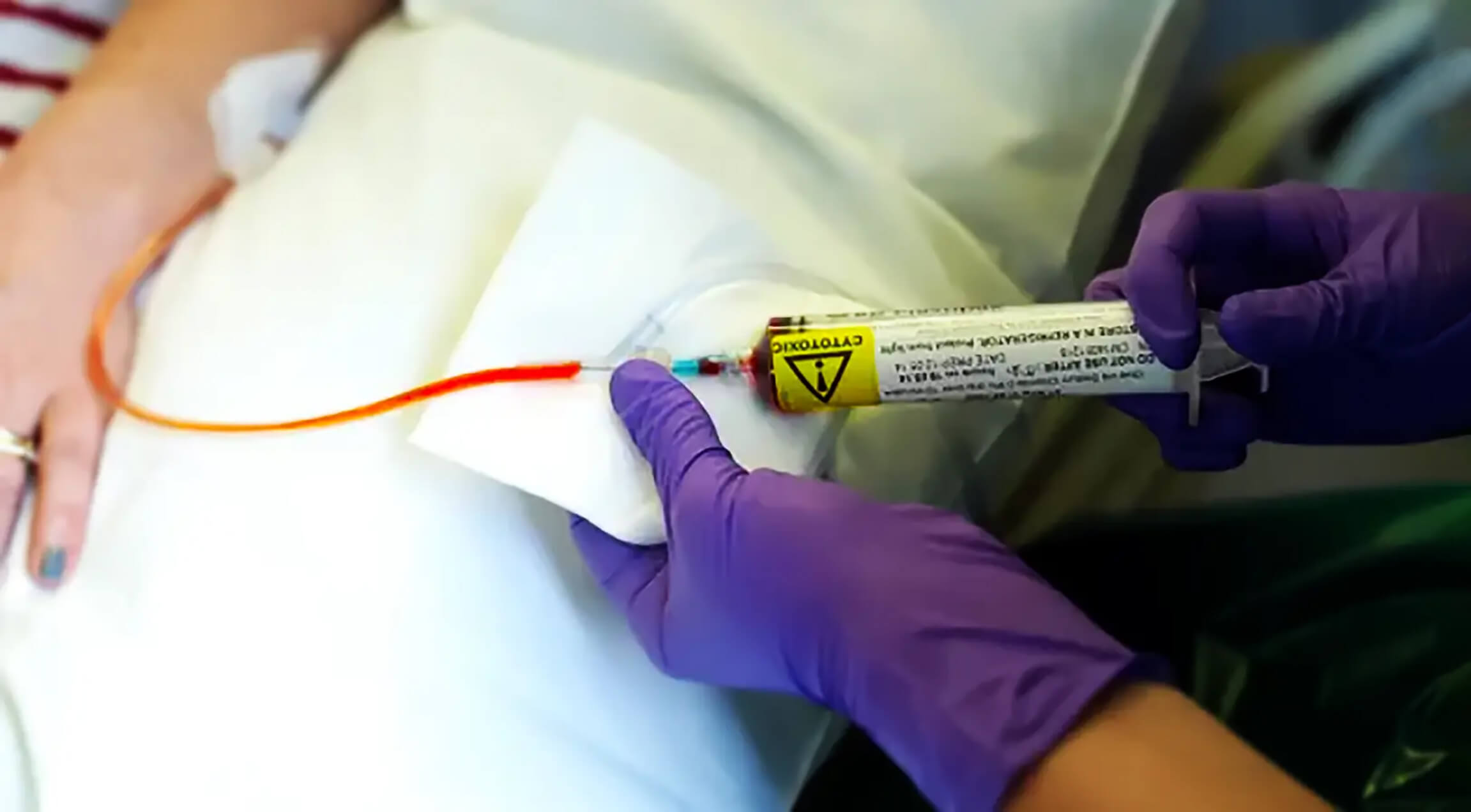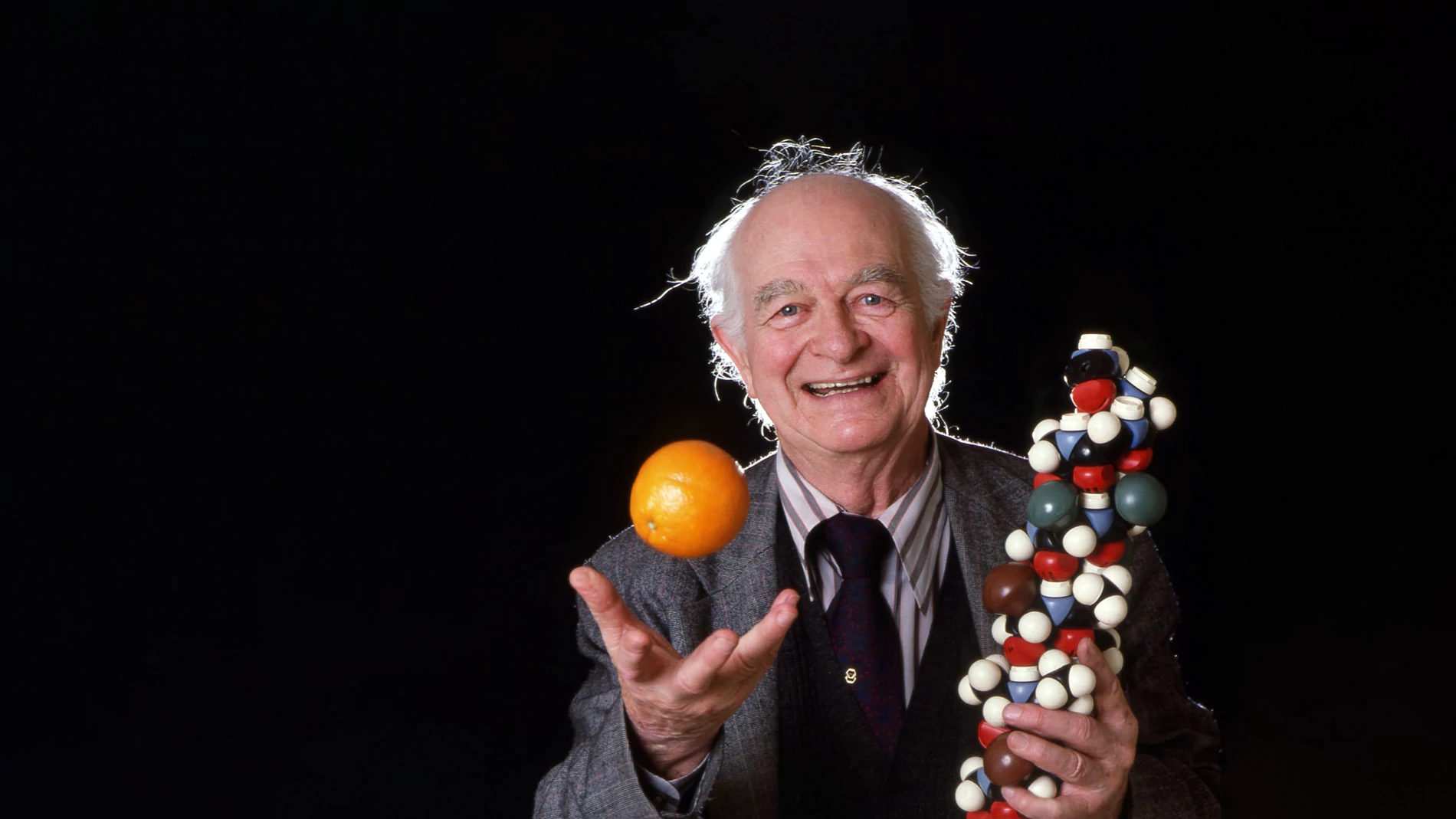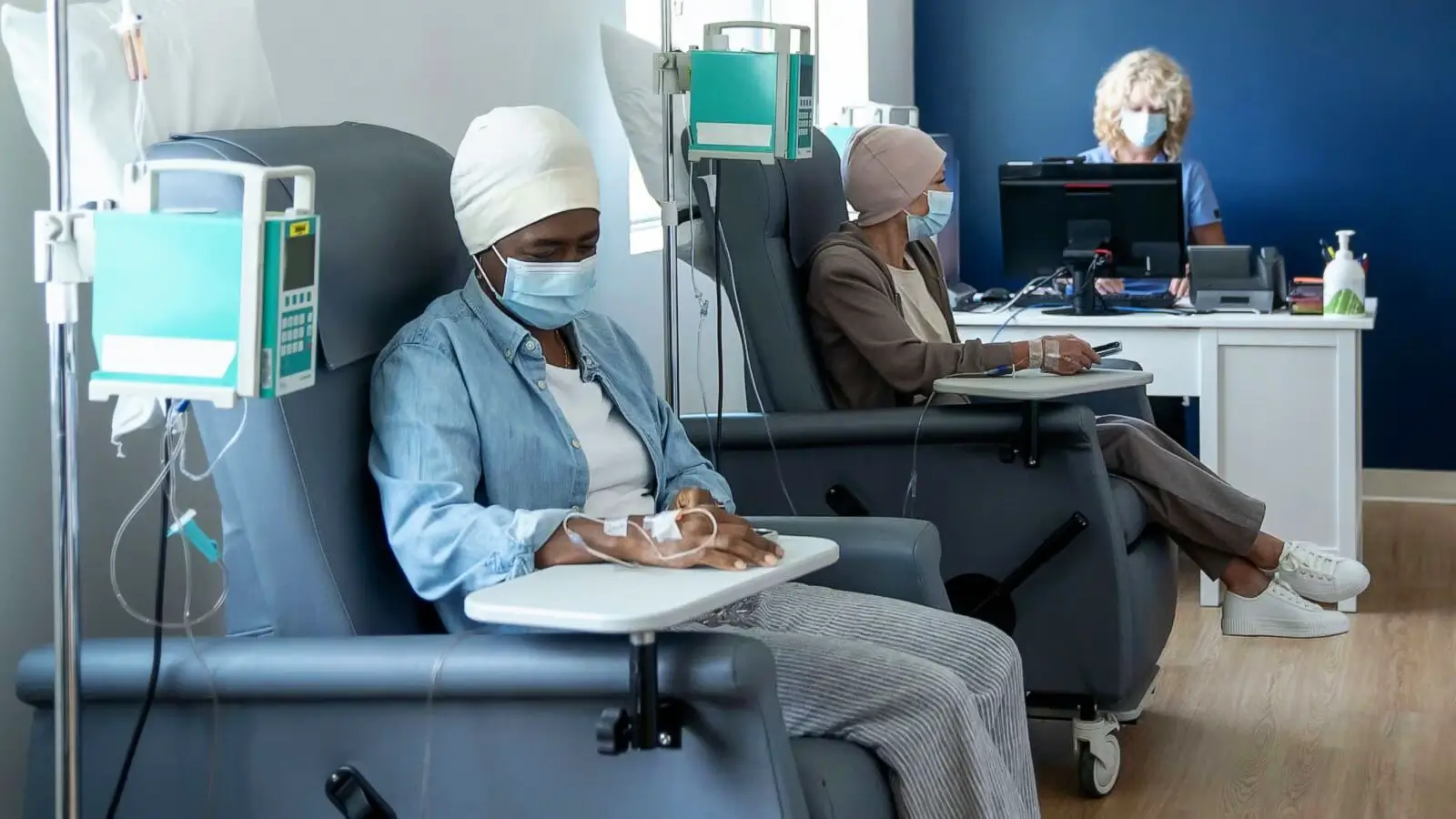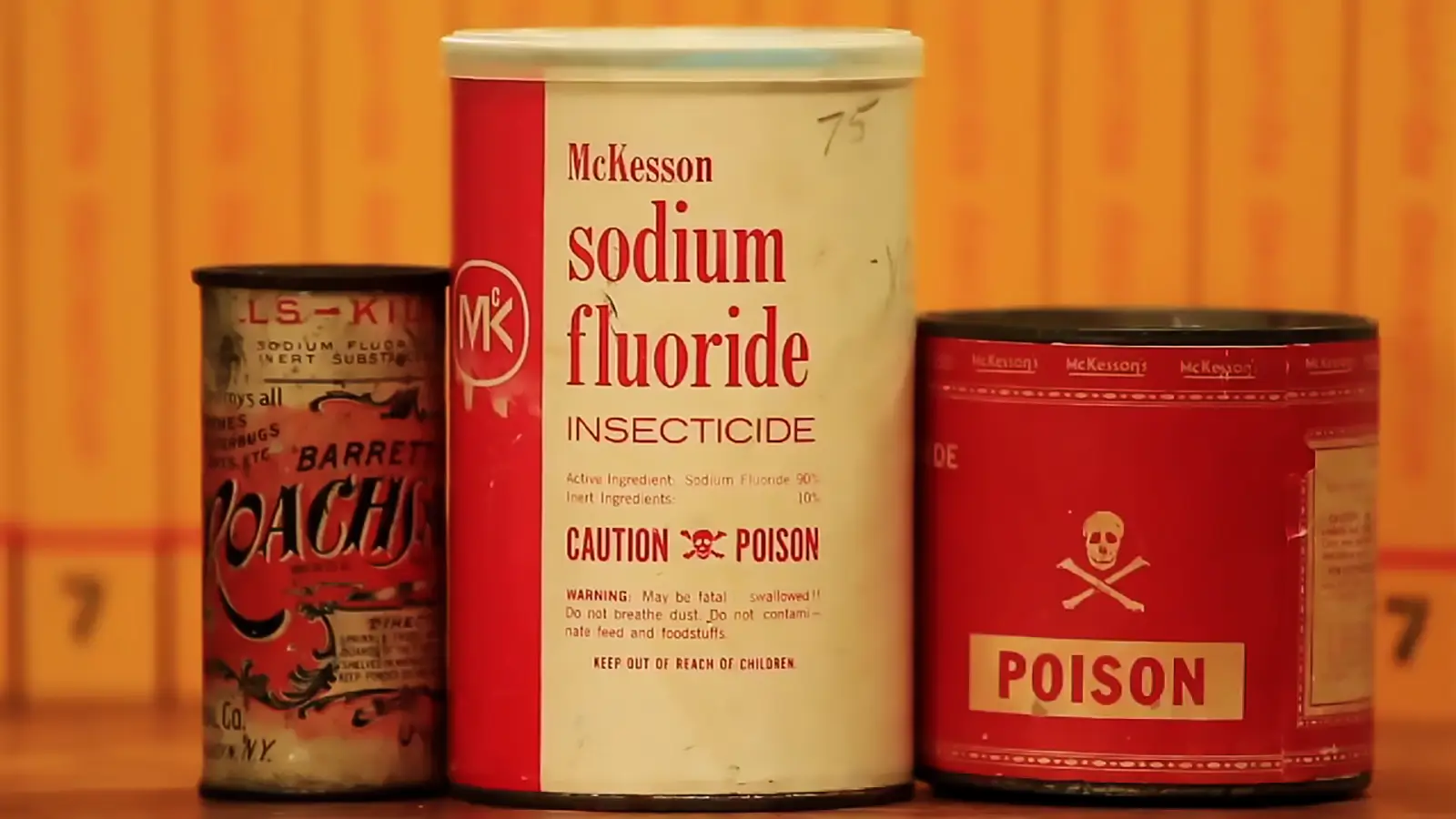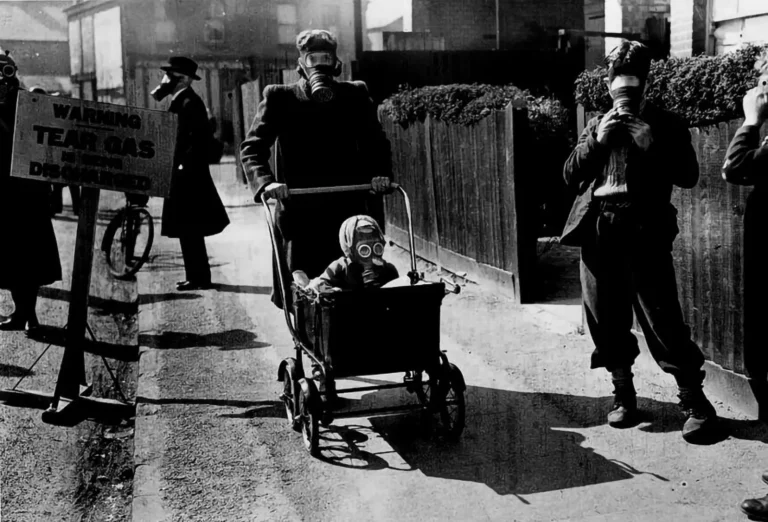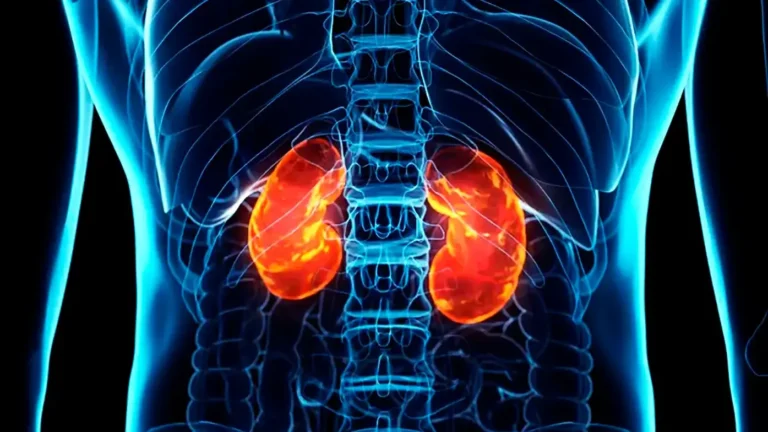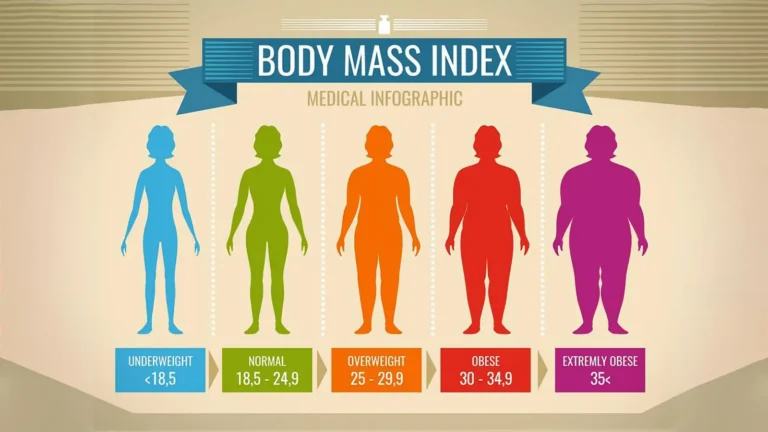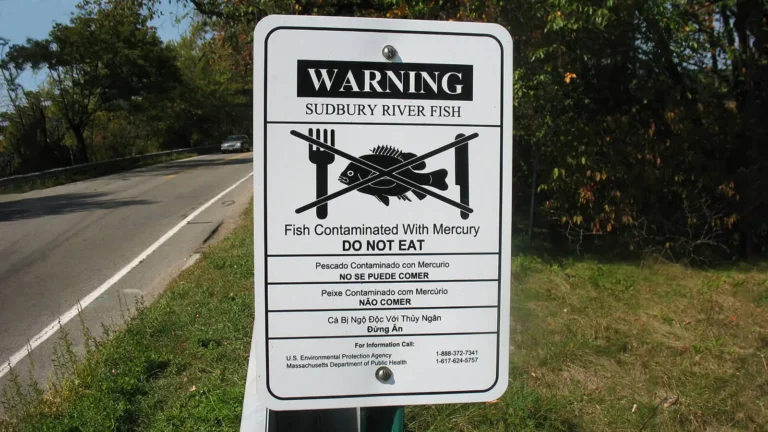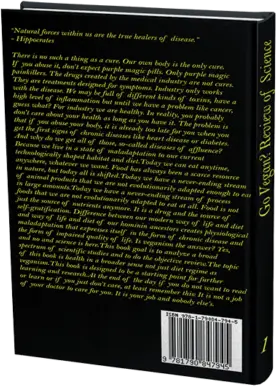Câncer, O que é Proibido Curas-máquina de Rife, análise de Histórico
A taxa de recuperação para pacientes que têm não-tratáveis câncer e foram declarou doente terminal, utilizando Repleto de Máquina de ressonância tecnologia foi de 100%.
Milos Pokimica
Escrito por: Milos Pokimica
Revisto Clinicamente Por: Dr. Xiùying Wáng, M.D.
Actualizado em 9 de Junho de 2023Royal Raymond Rife desenvolveu uma tecnologia que ainda hoje é comumente usada nas áreas de óptica, microscopia, eletrónica, radioquímica, bioquímica, balística e aviação, e particularmente em imagem e microscopia médica. Royal Raymond Rife também desenvolveu uma tecnologia (Máquina Rife) que provavelmente você não conhece. Durante a sua vida, recebeu 14 prémios diferentes. Rife frequentou a Universidade de Heidelberg, na Alemanha, onde recebeu um doutorado honorário em Parasitologia. Rife também recebeu um doutorado honorário em Ciências pela Universidade do Sul da Califórnia em 1936.
As invenções da espingarda incluem o microscópio ultravioleta heterodinâmico, um micro dissecador, e um micromanipulador.
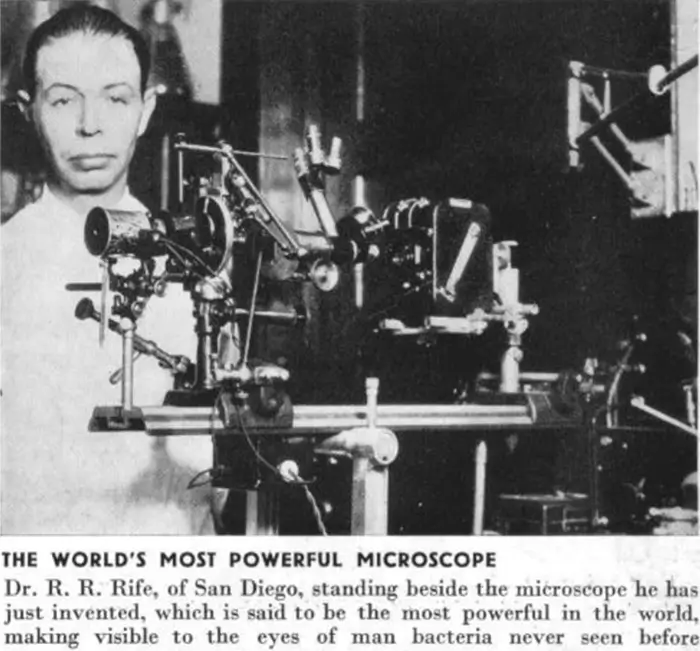
Ele não era apenas um charlatão, como a maioria das pessoas “instruídas” na área da medicina gostariam que você acreditasse. O seu negócio original, enquanto ainda frequentava a universidade, era com a empresa Carl Zeiss, nos escritórios da empresa em Nova Iorque e, mais tarde, nos escritórios da empresa na Alemanha, onde trabalhou diretamente com Carl Zeiss, Hans Luckel e outros cientistas na pesquisa, conceção e produção de excelentes microscópios. Passou cinco anos a trabalhar com esse grupo enquanto frequentava a Universidade de Heidelberg. Afirma-se que Rife trabalhou com a Marinha dos Estados Unidos antes e durante a Primeira Guerra Mundial e que foi nomeado Tenente-Comandante da USNR. Durante os anos que antecederam a Grande Depressão, o Dr. Rife trabalhou tanto para o Governo dos Estados Unidos como para a empresa Carl Zeiss Optics. Em determinado período, a sua base monetária se dissolveu e ele aceitou um emprego como motorista do multimilionário Henry Timkin. A associação do Dr. Rife com Henry Timkin foi muito proveitosa para ambos. Timkin fabricava rolamentos de rolos. Alguns dos rolamentos estavam a desmoronar-se devido a imperfeições no aço utilizado para os fabricar. Rife projetou e construiu um dispositivo de raios X que monitorizava todos os rolamentos que saíam e descartava todos os defeituosos antes que fossem enviados como produto acabado. Ele poupou milhões à empresa. Timkin ficou tão satisfeito que estabeleceu um pagamento mensal vitalício a Rife por fornecer a máquina de raios X especializada para o seu ambiente de produção.
Henry Timkin e o seu parceiro, Bridges permaneceram tão fascinados com o Dr. Rife e o seu trabalho que criaram um fundo para financiar um laboratório totalmente equipado em Point Loma, Califórnia, e para suportar as despesas de um programa de investigação no laboratório que foi criado. No laboratório acima mencionado, ele realizou a maior parte das suas experiências. A certa altura, Rife tinha até doze assistentes de laboratório a trabalhar para ele. Em 1916, os microscópios mais potentes podiam alcançar uma ampliação de 2500 diâmetros. Com este instrumento, um cientista podia ver parasitas, bolor, e muitas bactérias, mas ninguém tinha visto um vírus.
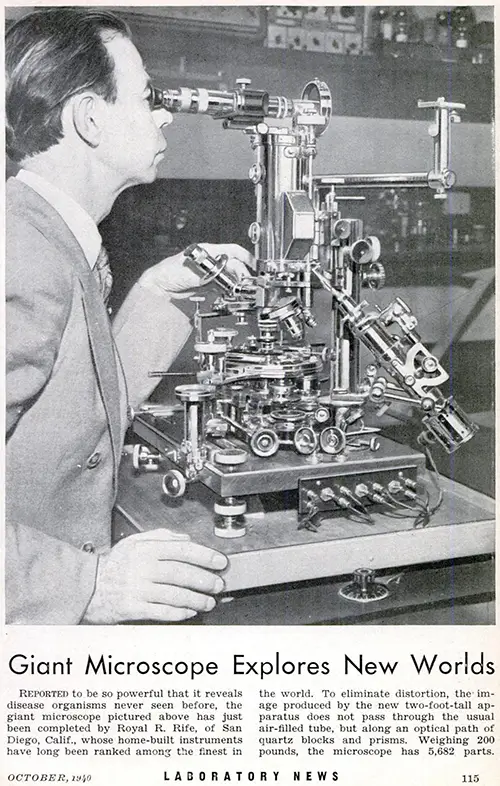
Rife construiu um instrumento de ampliação que funcionava com um princípio diferente dos microscópios existentes na sua época. O primeiro microscópio que lhe permitiu ver um vírus foi construído em 1920. Rife foi o criador do Microscópio Universal, que apresentou ao mundo em 1933 como o microscópio mais potente do mundo. Uma das várias características atraentes deste microscópio é que, ao contrário do microscópio eletrónico, o Microscópio Universal não mata as amostras sob observação e permite a observação de amostras vivas reais em todas as condições, indicando que não depende de fixação ou coloração para tornar visível ou definir. Com o seu microscópio, Rife tornou-se o primeiro ser humano a ver realmente um vírus vivo e, até muito recentemente, o Microscópio Universal era o único capaz de observar vírus vivos. Os microscópios eletrónicos modernos matam instantaneamente tudo. O microscópio Rife pode ver a atividade intensa dos vírus vivos à medida que mudam de forma para se adaptarem às mudanças no ambiente, se replicam rapidamente em resposta a carcinógenos e transformam células normais em células tumorais. Rife conseguiu isso utilizando várias formas de iluminação para tornar o vírus visível. Ele primeiro utilizou a técnica de usar luz para corar os objetos, pois compreendeu que as partículas dos corantes químicos eram muito grandes para entrar nas estruturas que ele tentava visualizar.
Além disso, os corantes utilizados na microscopia são frequentemente letais para as amostras. Um fator que permitiu obter essas imagens originais foi o uso, por Rife, de uma ferramenta chamada prisma contrarrotativo Risley. O raio refratado e polarizado normalmente oculta organismos invisíveis, que se tornariam visíveis em cores peculiares à sua estrutura ou composição química. Todos os elementos óticos eram feitos de quartzo em bloco, o que permite a passagem de raios ultravioleta. Por este meio, Rife descobriu que diferentes bactérias e vírus brilham a diferentes frequências. Se não compreende a ciência por detrás, pode ler este artigo Cancer, The Forbidden Cures-Rife Machine, Scientific Review. Isto provou que os organismos podiam ser classificados pelo seu índice de refracção ou, por outras palavras, pela sua frequência de ressonância. Por outras palavras, descobriu que eles vibram sob diferentes frequências. Rife classificou lentamente a assinatura espectroscópica única de cada micróbio, utilizando uma fixação espectroscópica com fenda. Depois, ele torceu gradualmente os prismas para focar a luz de um comprimento de onda individual sobre o microrganismo que estava a examinar. Depois ressonou com a frequência da assinatura espectroscópica do micróbio com base no facto agora estabelecido de que cada molécula oscila na sua frequência distinta.
Utilizando um microrganismo de comprimento de onda ressonante que não pode ser visto à luz branca, torna-se subitamente visível como um flash de luz quando são expostos à frequência de cor que ressoa com a sua assinatura espectroscópica distinta. A Rife era capaz de ver os organismos de outra forma invisíveis e observá-los como se comportam. Era capaz de ver organismos que mais ninguém conseguia ver com os microscópios comuns.
Rife estava tão à frente dos seus colegas de trabalho na década de 1930 que era difícil para eles compreenderem o que ele realmente fazia sem viajar diretamente para San Diego, ao laboratório de Rife, para verem por si próprios através do seu microscópio de vírus. E vários fizeram exatamente isso. Uma delas foi Virginia Livingston. Ela acabou por se mudar de Nova Jérsia para o bairro de Point Loma (San Diego), onde Rife morava, e tornou-se uma visitante regular do seu laboratório. Virginia Livingston é agora creditada por identificar o organismo que causa o cancro humano, com base em artigos de investigação que publicou em 1948. A verdade é que Rife tinha identificado o vírus do cancro humano em 1920. Ele chamou ao vírus do cancro ‘Cryptocides primordiales’. Virginia Livingston renomeou-o para ‘Progenitor Cryptocides’. Royal Rife nunca foi sequer mencionado nos seus artigos.
Na verdade, Rife raramente recebeu crédito pelas suas descobertas monumentais. Ele era um cientista modesto e humilde, comprometido em expandir as suas descobertas, em vez de ambicionar fama e glória. Começou o seu trabalho de investigação sobre a tuberculose em 1920. Em pouco tempo, ficou claro para Rife que havia mais envolvido nesta doença do que uma bactéria. Isso encorajou-o a desenvolver microscópios de “vírus”, dos quais dois precederam o Universal. Rife foi o primeiro cientista a isolar e fotografar a tuberculose ativa, bem como muitos outros vírus. Rife também trabalhou no isolamento de um vírus específico do cancro, observando que ele emitia uma emanação roxa-avermelhada única. Não houve sucesso até que Rife, por engano, deixou um tubo à luz de uma lâmpada ionizante. Ele percebeu que o tubo ficou turvo, registrando atividade.
O seu trabalho conduz ao primeiro culto bem sucedido do vírus fora de um hospedeiro vivo. Rife extraiu o vírus do cancro de uma ”massa mamária humana”. Ele filtrou, cultivou e recultivou essas amostras mais de dez vezes ao longo de um período de duzentas e quarenta horas. Em seguida, inseriu a cultura de última geração num rato vivo. O rato inevitavelmente desenvolveu cancro. Rife então extraiu o cancro, extraiu o vírus e repetiu o processo. Ele realizou esse procedimento mais de quatrocentas vezes.
Ele estabeleceu categoricamente que os tumores cancerígenos eram induzidos por vírus em todos os casos. Depois que o Dr. Rife aprendeu a ver um vírus, o próximo passo lógico foi desenvolver um método para matar o vírus ou micróbio sem causar danos ao hospedeiro. Desde os dias de Nikola Tesla e o seu trabalho, os homens da ciência sabiam da conexão das frequências com o funcionamento do corpo humano, então Rife voltou-se para as frequências eletromagnéticas porque podia detectar bactérias e vírus em frequências únicas e, em seguida, expô-los e observar os efeitos. Ele descobriu que cada microrganismo tinha uma frequência distinta na qual ressoava e ficava indefeso. Rife chamou isso de “taxa oscilatória mortal.”
Repetidamente, ele observava o vírus absorver energia e morrer quando uma determinada frequência era aplicada. Às vezes, eles até explodiam. Ele criou gráficos revelando quais configurações de frequência matariam quais micróbios ou vírus. Se ele não tivesse inventado o seu microscópio, não teria havido nenhum tratamento baseado na ressonância. Inúmeros relatórios e notícias surgiram sobre essas conquistas extraordinárias. O seu trabalho tornou-se conhecido por muitos médicos na região sul da Califórnia. Alguns deles vieram de todas as partes dos Estados Unidos para observar o que ele estava a fazer e verificar os seus resultados. Em novembro de 1931, o Dr. Milbank Johnson chamou quarenta e quatro médicos da região de Los Angeles à sua casa em Pasadena, Califórnia, para reconhecer Rife pelo trabalho que estava realizando. O Dr. Royal Rife foi reconhecido como o homem que acabou com todas as doenças que já existiram. Bem, pelo menos aquelas que são infecciosas e podem ser bombardeadas com ressonância. O banquete foi até chamado de “O Fim de Todas as Doenças”.”
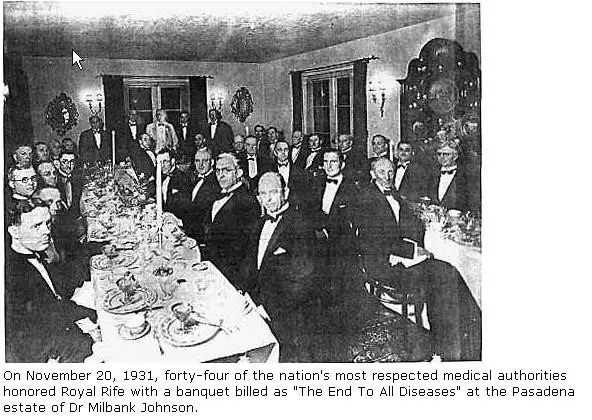
Em 1934, um grupo de médicos liderado pelo Dr. Milbank Johnson de Pasadena, Califórnia, numa experiência que foi patrocinada pela Universidade da Califórnia, trouxe dezasseis doentes terminais de um hospital em San Diego. Eles foram irradiados com as frequências recomendadas pelo Dr. Royal Rife durante noventa dias para activar a ressonância e destruir o cancro.
Foi a primeira vez na história que doentes com cancro em fase terminal foram completamente curados.
Leia novamente esta frase.
Foi a primeira vez na história que doentes com cancro em fase terminal foram completamente curados.
Catorze dos doentes ficaram completamente livres de qualquer cancro nessa altura. A terapia foi então ajustada, ou seja, a frequência ressonante e os dois pacientes restantes também responderam.
A taxa de recuperação de pacientes com cancro incurável e declarados terminais pela indústria médica convencional, utilizando a tecnologia ressonante de Rife, foi de 100%.
Leia novamente esta frase.
A taxa de recuperação dos doentes que têm cancro não tratável e que foram declarados doentes terminais pela indústria médica aceite por utilizando a ressonância de Rife A tecnologia era 100%.
Em 1939, o Dr. Rife foi formalmente convocado para discursar na Royal Society of Medicine, em Londres, Inglaterra, que havia verificado as suas descobertas. Recebeu ainda convites para dar palestras na França e na Alemanha. O Dr. R. Seidel descreveu e publicou formalmente a terapia do sistema Rife Ray Tube para o tratamento do cancro na revista do Franklin Institute, em fevereiro de 1944. Os tratamentos do Dr. Rife para infecções virais e bacterianas e os seus microscópios foram descritos e elogiados pelo Instituto Smithsonian num artigo publicado na revista do Instituto em 1944. Um relatório do Instituto Smithsonian confirma o trabalho de Rife. Intitulado “O Novo Microscópio”, do Dr. R.E. Seidel (relatório #3781), afirma:
“Sob o microscópio universal, organismos causadores de doenças, como os do cancro... e outras doenças, podem ser observados a sucumbir quando expostos a certas frequências letais...”
Levou muito tempo, anos da sua vida, trabalhando 48 horas de cada vez, até detectar as frequências que explicitamente destruíam o herpes, a poliomielite, a meningite espinal, o tétano, a gripe, e um número imenso de outros organismos de doenças perigosas.
Inicialmente, tentou-se comprar a empresa de Rife. Morris Fishbein, um médico que se tornou editor do Journal of the American Medical Association, enviou um advogado a Rife com “uma oferta que ele não poderia recusar”.”
Rife recusou.
Nunca saberemos os termos exactos desta oferta, mas é altamente provável que não quisessem que a sua máquina se tornasse comercialmente disponível. Provavelmente tentaram suborná-lo para destruir a sua invenção. Por exemplo, quando Fishbein fez uma oferta semelhante a Hoxsey, ele recusou. Fishbein utilizou as suas imensamente fortes associações governamentais para mandar prender Hoxsey 125 vezes em 16 meses. As acusações foram sempre retiradas do tribunal, mas o assédio continuou. Tornou-se tão mau que a AMA afixou panfletos em todos os correios de todo o país por assustar as pessoas com a utilização de Hoxsey e quaisquer outros tratamentos alternativos de cancro. Contudo, o que temos de compreender é que ele não agiu sozinho. Na altura, ele era apenas um frontman da AMA. Mais tarde, em 1961, tornou-se o editor fundador da Medical World News, uma revista para médicos. Em 1970, dotou o Morris Fishbein Center para o estudo da história da ciência e da medicina na Universidade de Chicago.
No entanto, Fishbein e a AMA devem ter reconhecido que essa abordagem teria um efeito contrário se usada contra Rife. Eles não podiam prender Rife como fizeram com Hoxsey por exercer medicina sem licença. Além disso, o julgamento baseado em acusações forjadas significaria que autoridades médicas proeminentes que trabalhavam com Rife apresentariam seus depoimentos em apoio a Rife e a notícia de sua invenção se espalharia para o público em geral. A defesa certamente apresentaria provas, como o estudo médico de 1934 realizado com a USC. Se eles tivessem um julgamento público sobre uma terapia indolor que curou 100% de pacientes com cancro terminal com provas médicas e que também não custava nada para usar, exceto um pouco de eletricidade. Bem, isso não era o que os poderes constituídos queriam. Rife não apareceu do nada. Ele era um cientista conhecido que passou décadas a recolher provas precisas do seu trabalho. Ele tinha filmes e fotografias em stop-motion que poderiam ser divulgados ao público e assim por diante.
Tiveram de usar tácticas diferentes e foram utilizados.
O primeiro incidente foi o desaparecimento gradual de filmes, fotografias, componentes, registos escritos e outras provas do laboratório de Rife. O culpado nunca foi apanhado.
Depois, enquanto Rife tentava replicar os seus dados em falta (quando os computadores não estavam disponíveis), alguém vandalizou os seus caros microscópios de vírus.
Então, todo o laboratório “misteriosamente” ardeu na altura em que os homens que dirigiam o laboratório estavam a visitar Rife em San Diego.
Então, os documentos no laboratório de Rife em San Diego desapareceram “misteriosamente”, assim como partes dos seus microscópios.
O golpe final aconteceu mais tarde, quando a polícia apreendeu ilegalmente o restante dos 50 anos de pesquisa de Rife.
Depois o médico que mais ajudou o Dr. Royal Rife a receber reconhecimento pelo seu trabalho foi o Dr. Milbank Johnson. Um dia foi levado para o hospital para o que se pensava ser um problema menor ao atender médicos em 1944, mas morreu lá "misteriosamente" de intoxicação alimentar.
Rife e os seus parceiros criaram uma empresa chamada Ray Beam Tube Corporation para construir a Máquina Rife. Ele contratou um engenheiro para lidar com a produção. Fishbein supostamente apoiou o engenheiro a processar Rife. O processo foi longo e caro. Rife ganhou, mas o custo do processo causou a destruição financeira da empresa e, em tempos de grande depressão, o fim da produção. Uma enorme quantia em dinheiro foi gasta para garantir que os médicos que tinham visto a terapia de Rife e conheciam o seu trabalho esquecessem tudo ou fossem ameaçados pela Associação Médica Americana e pelo Estado da Califórnia com a perda das suas licenças se continuassem no programa. Arthur Kendall, que trabalhou com Rife no vírus do cancro, aceitou quase um quarto de milhão de dólares para se ‘aposentar’ repentinamente no México. O Dr. George Dock, que colaborou com Rife, foi silenciado com uma enorme bolsa, juntamente com as mais altas honras que a AMA poderia conceder. O Dr. Couche e o Dr. Milbank Johnson também desistiram do trabalho de Rife e voltaram a prescrever medicamentos.
Este tratamento destruiu emocionalmente o próprio Rife e todo o seu programa foi dissolvido. A perda do seu laboratório e as consequências mentais e emocionais do processo judicial foram suficientes para tornar Rife alcoólatra. Durante 1950, Rife trabalhou para melhorar os instrumentos de energia com John Crane. John Crane acabou ficando com os direitos sobre os microscópios. Em 1960, autoridades médicas invadiram o laboratório de Crane e confiscaram todos os dispositivos e registos. Como se isso não bastasse, ele também foi acusado pelo Estado da Califórnia por cometer fraude e enviado para a prisão.
Diz-se que a Rife escapou para o México nesta altura. Não trabalhou com ninguém depois daquele último incidente. Rife morreu em 1971, no Hospital Grossman em El Cajon, Califórnia, de um ataque cardíaco após ter passado os últimos anos da sua vida num lar de idosos em El Cajon. Ficou sem amigos ou sem fundos. Descobriu uma abordagem incrivelmente simples e electrónica para a cura de todas as doenças. Fez a descoberta de baixo custo que poderia acabar com o sofrimento de incontáveis milhões. Teria mudado a vida na Terra para sempre. Certamente, o mundo médico apressar-se-ia a abraçá-la com todos os elogios e recompensas financeiras imagináveis. Contraiu uma cura universal que torna os medicamentos obsoletos, e o único custo da sua utilização é a electricidade, pelo que a indústria farmacêutica poderá ficar entusiasmada ao saber do seu trabalho. É claro que alguns de vós poderão considerar isto apenas como uma divertida peça de ficção. Façam a vossa própria investigação e acreditem no que quiserem. Na realidade, esta tecnologia pode ter um grande potencial se for devidamente desenvolvida. A única questão aqui é: poderiam visar todos os vírus ou apenas alguns deles? Sabemos que curou o cancro na faixa dos 100%. No entanto, se a ressonância dos micróbios estiver demasiado próxima do resto da radiação das células humanas transferiria alguma da energia para elas queimando tecido regular, mas se a frequência for distinta, então isto poderia funcionar. Actualmente, por exemplo, há milhares de pessoas que têm um diagnóstico de doença de Lyme, mas o tratamento antibiótico não está a produzir alívio a longo prazo. A terapia com máquinas de vida está a revelar-se valiosa e a única terapia a longo prazo disponível para a doença de Lyme. Mas nunca saberíamos realmente. Não há dados que sejam originais do trabalho da Rife. Nenhuma ciência depois dele foi feita.
A magnitude deste crime insano eclipsa cada assassinato em massa na história.
Referências:
Passagens seleccionadas de um livro: Pokimica, Milos. Go Vegan? Revisão da Ciência-Parte 2. Kindle ed., Amazon, 2018.
Publicações Relacionadas
Você tem alguma dúvida sobre saúde e nutrição?
Eu adoraria ouvir de você e respondê-las em meu próximo post. Agradeço sua contribuição e opinião e espero ouvir de você em breve. Eu também convido você a siga-nos no Facebook, Instagram e Pinterest para mais conteúdos sobre dieta, nutrição e saúde. Pode deixar um comentário e ligar-se a outros entusiastas da saúde, partilhar as suas dicas e experiências e obter apoio e encorajamento da nossa equipa e comunidade.
Espero que este post tenha sido informativo e agradável para si e que esteja preparado para aplicar os conhecimentos que aprendeu. Se achou este post útil, por favor partilhá-lo com os seus amigos e familiares que também possam beneficiar com isso. Nunca se sabe quem poderá precisar de alguma orientação e apoio no seu percurso de saúde.
– Você Também Pode Gostar –

Aprender Sobre Nutrição
Milos Pokimica é médico de medicina natural, nutricionista clínico, escritor de saúde e nutrição médica, e conselheiro em ciências nutricionais. Autor da série de livros Go Vegan? Revisão de Ciênciaopera também o website de saúde natural GoVeganWay.com
Medical Disclaimer
GoVeganWay.com traz análises das pesquisas mais recentes sobre nutrição e saúde. As informações fornecidas representam a opinião pessoal do autor e não pretendem nem implicam substituir aconselhamento, diagnóstico ou tratamento médico profissional. As informações fornecidas são apenas para fins informativos e não se destinam a servir como substituto para consulta, diagnóstico e/ou tratamento médico de um médico ou profissional de saúde qualificado.NUNCA DESCONSIDERE o CONSELHO MÉDICO PROFISSIONAL OU adiar a BUSCA de TRATAMENTO MÉDICO por causa DE ALGO QUE TENHA LIDO OU ACESSADO por MEIO de GoVeganWay.com
NUNCA APLIQUE QUAISQUER MUDANÇAS de estilo de VIDA OU QUALQUER MUDANÇA COMO UMA CONSEQUÊNCIA DE ALGO QUE TENHA LIDO NO GoVeganWay.com ANTES de CONSULTORIA de LICENÇA MÉDICA.
No caso de uma emergência médica, ligue para o médico ou para o 911 imediatamente. GoVeganWay.com não recomenda ou endossa qualquer específicos, grupos, organizações, exames, médicos, produtos, procedimentos, opiniões ou outras informações que podem ser mencionadas dentro.
Sugestões do Editor –
Milos Pokimica é escritor especializado em saúde e nutrição e consultor em ciências nutricionais. Autor da série de livros Go Vegan? Revisão de Ciênciaopera também o website de saúde natural GoVeganWay.com
Artigos Mais Recentes -
Superior De Saúde De Notícias — ScienceDaily
- Why consciousness exists at allon Dezembro 15, 2025
Consciousness evolved in stages, starting with basic survival responses like pain and alarm, then expanding into focused awareness and self-reflection. These layers help organisms avoid danger, learn from the environment, and coordinate socially. Surprisingly, birds show many of these same traits, from subjective perception to basic self-awareness. This suggests consciousness is far older and more widespread than once believed.
- AI found a way to stop a virus before it enters cellson Dezembro 15, 2025
Researchers discovered a hidden molecular “switch” that herpes viruses rely on to invade cells. By combining AI, simulations, and lab experiments, they identified and altered a single amino acid that shut down viral entry. What once might have taken years was achieved far faster using computational tools. The findings open new possibilities for designing future antiviral treatments.
- New study shows some plant-based diets may raise heart disease riskon Dezembro 15, 2025
Researchers tracking over 63,000 adults found that high-quality, minimally processed plant foods significantly reduce cardiovascular risk. But when those plant foods are ultra-processed, the advantage disappears—and can even backfire. Some ultra-processed plant diets increased risk by 40%. The study urges a shift toward whole, naturally nutrient-rich plant foods.
- These simple habits could make your brain 8 years younger, study findson Dezembro 15, 2025
New research shows that your brain’s “true age” can shift dramatically depending on how you live, with optimism, restorative sleep, stress management, and strong social support acting like powerful anti-aging tools. Using advanced MRI-based brain-age estimates, scientists found that people with multiple healthy lifestyle factors had brains up to eight years younger than expected — even among those living with chronic pain.
- Anxiety and insomnia linked to sharp drops in key immune cellson Dezembro 15, 2025
Natural killer cells act as the immune system’s rapid-response team, but the stress of anxiety and insomnia may be quietly thinning their ranks. A study of young women in Saudi Arabia found that both conditions were linked to significantly fewer NK cells—especially the circulating types responsible for destroying infected or abnormal cells. As anxiety severity increased, NK cell levels dropped even further, suggesting a stress-driven weakening of immune defenses.
- Cannabis compounds show unexpected power against ovarian canceron Dezembro 15, 2025
Scientists have discovered that key compounds from cannabis—CBD and THC—show surprisingly strong effects against ovarian cancer cells. Used together, they slow cell growth, reduce colony formation, and may even block the cancer’s ability to spread. Even more promising, the treatment caused minimal harm to healthy cells and appears to work by restoring a disrupted signaling pathway that fuels tumor growth.
- Mayo Clinic neurosurgeon reveals 8 back pain myths to stop believingon Dezembro 15, 2025
Back pain is wrapped in persistent myths, but many are far from the truth. From misconceptions about heavy lifting and bed rest to confusion over posture, exercise, and surgery, Dr. Meghan Murphy breaks down what really causes pain and what actually helps. Her insights reveal that everyday habits, movement, and smart prevention often make a bigger difference than people realize.
PubMed, #vegan-dieta –
- Healthful and Unhealthful Plant-Based Diets and Their Association with Cardiometabolic Targets in Women Diagnosed with Breast Cancer: A Cross-Sectional Analysis of a Lifestyle Trialon Dezembro 11, 2025
CONCLUSIONS: Maintaining cardiometabolic risk factors within normal ranges is clinically relevant in BCS, and this may be more likely when a plant-based diet is consumed, especially if low in unhealthy plant foods.
- Dietary and Lifestyle Patterns and Their Associations with Cardiovascular and Inflammatory Biomarkers in Vegans, Vegetarians, Pescatarians, and Omnivores: A Cross-Sectional Studyon Dezembro 11, 2025
Background: Plant-based diets are associated with reduced cardiometabolic risk, yet the influence of lifestyle behaviors on these benefits remains insufficiently understood. Objective: To assess the combined impact of dietary patterns and lifestyle behaviors on body composition, lipid profiles, and inflammatory biomarkers in healthy young adults. Methods: In this cross-sectional study, 155 participants aged 18-39 years were categorized into four dietary groups: vegans (n = 48), vegetarians (n […]
- Functional and Nutritional Properties of Lion’s Mane Mushrooms in Oat-Based Desserts for Dysphagia and Healthy Ageingon Dezembro 11, 2025
Hericium erinaceus (Lion’s Mane mushroom) is a medicinal species recognised for its neuroprotective and antioxidant properties. This study investigated its potential as a functional ingredient in oat milk-based desserts formulated for individuals with dysphagia. Freeze-dried Lion’s Mane powder (LMP), containing high-quality protein (~16%, amino acid score 88%), dietary fibre (~31%), and phenolic compounds (72.15 mg GAE/g), was incorporated at varying levels using gelatin or iota-carrageenan […]
- “A football team with no midfield”: A qualitative analysis of anti-vegan stigma in Italyon Dezembro 7, 2025
A growing body of research has demonstrated the prevalence of unfavourable attitudes towards individuals who adhere to a vegan diet and has provided empirical evidence to support the existence of an anti-vegan ideology. The present study aims to contribute to extant knowledge by examining the social perception of veganism and vegans in Italy. Italy is a nation characterised by a traditional culture of food that serves as a significant catalyst for collective identification and national pride….
- Plant-based dietary index on the Mediterranean and a vegan diet: a secondary analysis of a randomized, cross-over trialon Dezembro 5, 2025
CONCLUSION: These findings suggest that, replacing animal products even with the “unhealthful” plant-based foods on a vegan diet was associated with weight loss.
Postagens aleatórias –
Postagens em destaque –
Últimas do PubMed, #dieta baseada em vegetais –
- Identification of effective plant-based oils for use in aquafeed: An evaluation of impact on gamete quality and developmental success using zebrafish (Danio rerio) as a screening organismpor Seyed-Mohammadreza Samaee on Dezembro 14, 2025
To evaluate the effectiveness of zebrafish as a screening system for identifying appropriate plant oils (POs) for aquafeed, Artemia nauplii (AN) were enriched with three single- cultivar olive oils (OO): Koroneiki, Parseh, and Arghavan. The resulting AN (ANKor, ANPar, ANArg, and AN36 [36 h starved AN, control]) were then fed to 360 fish (3.5 cm) for one month. The fatty acid (FA) profile of the AN was reflected in the ova and influenced both sperm motility and density, which in turn affected […]
- The Effect of Dietary Interventions on Human Vascular Function in the Context of Acute Psychological Stress: A Scoping Reviewpor Rosalind Baynham on Dezembro 14, 2025
Episodes of acute psychological stress increase the risk for cardiovascular diseases, partially through stress-induced impairments in vascular function. During psychologically stressful periods, individuals are more likely to consume unhealthy foods and fewer fruits and vegetables. Yet, the impact of dietary choices and their nutritional composition on vascular function in the context of psychological stress is unclear. In this scoping review, comprehensive database searches were carried out […]
- Plant-based diets, gut microbiota, blood metabolome, and risk of colorectal, liver and pancreatic cancers: results from a large prospective cohort study of predominantly low-income Americanspor Fangcheng Yuan on Dezembro 14, 2025
CONCLUSIONS: A diet high in healthy plant foods and low in animal foods was inversely associated with liver cancer risk and with CRC risk among screening-naïve participants. These associations may be partly mediated through gut microbiota and systemic metabolism.
- Vegetarian diet and likelihood of becoming centenarians in Chinese adults aged 80 years or older: a nested case-control studypor Yaqi Li on Dezembro 14, 2025
CONCLUSIONS: Targeting individuals of advanced age (80+ years) in China, we found that individuals following vegetarian diet had lower likelihood of becoming centenarians relative to omnivores, underscoring the importance of a balanced high-quality diet with animal- and plant-derived food composition for exceptional longevity, especially in the underweight oldest-old.
- Priority of nutrition and exercise in depression management: triangulating mini-review of past and recent evidence with clinical practice guidelinespor Shannon Rogers on Dezembro 14, 2025
CONCLUSIONS: Disparities that exist in leading depression management guidelines vis-à-vis inclusion of evidence-informed nutrition and PA/PE recommendations, warrant reconciliation. Evidence supporting anti-depressant WFPB nutrition and limiting pro-inflammatory animal-sourced food and UPF and supporting anti-inflammatory aerobic exercise and resistance training warrants being translated into national/international depression management guidelines as consistently as recommendations for…
- The effect of a diet based on vegetable and dairy protein on biochemical and functional indicators of sarcopenia in patients with liver cirrhosis: a randomized controlled trialpor Mahdiyeh Taghizadeh on Dezembro 13, 2025
CONCLUSIONS: In conclusion, a vegetable and dairy protein-based diet effectively inhibited significant elevations in ammonia levels compared to the standard diet in persons with liver cirrhosis; however, anthropometric parameters and muscle function did not differ between two groups.


